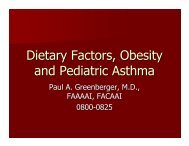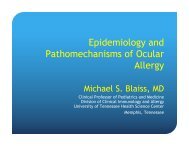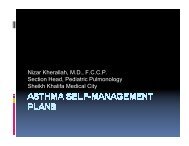Dubai Final-v20.indd - World Allergy Organization
Dubai Final-v20.indd - World Allergy Organization
Dubai Final-v20.indd - World Allergy Organization
Create successful ePaper yourself
Turn your PDF publications into a flip-book with our unique Google optimized e-Paper software.
ABstrACts<br />
ABstrACts<br />
3314<br />
PrEValEnCE oF allErgiC rHiniTiS in SCHool CHilDrEn PoPUlaTion oF TBiliSi anD WESTErn gEorgia<br />
Kherkheulidze, m. , Adamia, n. , Kandelaki, E. and Kavlashvili, n.<br />
Pediatrics, state medical University, tbilisi, georgia.<br />
the aim of the study was assessment of prevalence of allergic rhinitis in schoolchildren population of tbilisi and Western georgia<br />
region. the cross sectional research was conducted through questioning of the random and representative groups of population.<br />
schools and groups for study were selected by simple randomization.<br />
First stage of research covered 5569 children 53.7 % boys and 46.3 % girls aged from 6 to 16, who were divided into 2 groups –<br />
i group consist with 1049 child aged 6-10 years and ii group (1651 children ) aged 11-16 years. statistical data processing was<br />
provided by software package sPssv12.<br />
According to questioning, repeated sneezing episodes were identified in 14, 2 % of i group and 18, 7 % in elder group. the study<br />
reviled that most frequent symptom of allergic rhinitis is rhinorea and pruritus, while most disturbing symptom is nasal obstruction.<br />
Pruritus was indicated in 15.7 % elder group 20, 1 % in younger group. rhinorrhea was stated in 16.4, mostly among older<br />
schoolchildren. nasal obstruction was identified in 15.9 of respondents, with high frequency in younger schoolchildren.<br />
spread of the symptoms of Ar was reliably higher among boys (p

















